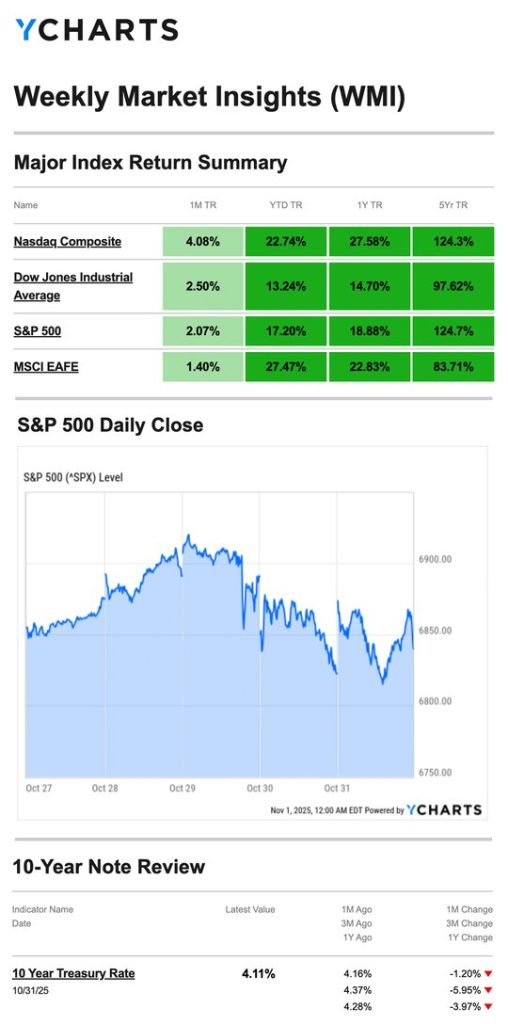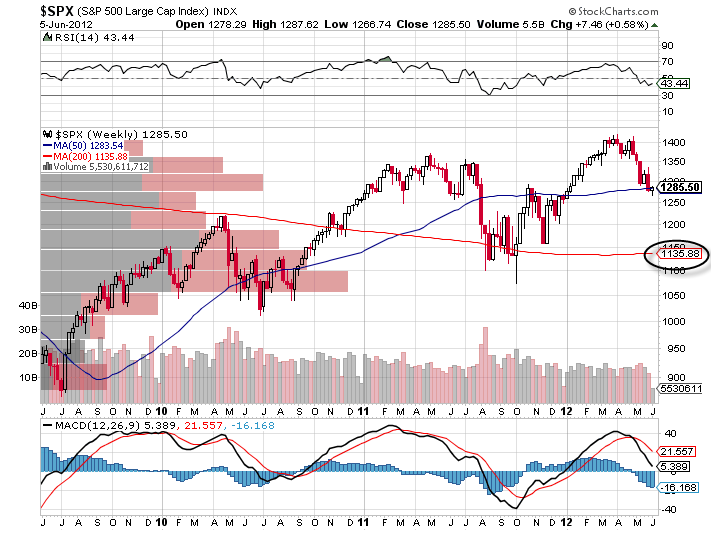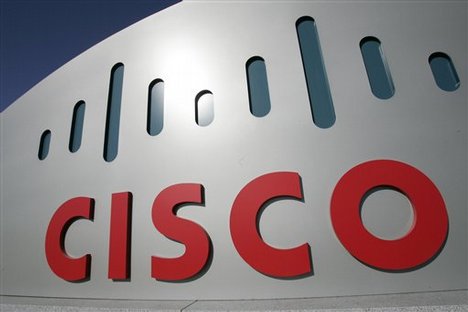By: Gerry Sparrow
Stocks rose last week as trade developments, positive Q3 corporate results, and momentum in megacap tech drove another rally, despite some cautious comments from the Fed.
The Standard & Poor’s 500 Index gained 0.71 percent, while the tech-heavy Nasdaq Composite Index picked up 2.24 percent. The Dow Jones Industrial Average rose 0.75 percent. By contrast, the MSCI EAFE Index, which tracks developed overseas stock markets, fell 0.55 percent.1,2
Stocks Up for Third Straight Week
Stocks rose over the first half of the week on news that Chinese and U.S. officials were working on a trade deal. Meanwhile, a rise in AI-related tech names lifted the broader market ahead of the Federal Open Market Committee (FOMC) meeting. All three major averages notched record closing highs for the first two days of the week, including the S&P 500 closing above 6800 for the first time.3,4
Stocks continued their rise Wednesday morning as the AI trade continued to fuel momentum. But markets wobbled following the FOMC’s decision to cut interest rates by a quarter percentage point. Chair Powell’s comments that the Fed may not adjust rates in December cut short the market’s rally.5,6Stocks bounced out of the gate on Friday, with the Nasdaq leading gains for all three major averages as several megacap tech companies rallied on upbeat Q3 results and other corporate news.7

Source: YCharts.com, November 1, 2025. Weekly performance is measured from Monday, October 27, to Friday, October 31. TR = total return for the index, which includes any dividends as well as any other cash distributions during the period. Treasury note yield is expressed in basis points.
‘Not a Foregone Conclusion’
As widely expected, the Federal Reserve cut short-term interest rates by 0.25 percent. But as often happens for those trying to read the Fed tea leaves, it was the finer messaging points that moved the markets.
Fed Chair Jerome Powell said in his post-meeting press conference that another rate adjustment in December was “not a foregone conclusion.” He added that Fed policy is “not on a pre-set course.” Part of that, he said, was due to the ongoing government shutdown and the resulting dearth of economic data—and the challenge in setting monetary policy without ongoing reports.8
This Week: Key Economic Data
Monday: PMI Composite–Manufacturing. ISM Manufacturing. Construction Spending.* Auto Sales. Fed governor Lisa Cook speaks.
Tuesday: Trade Deficit.* Factory Orders. Job Openings.
Wednesday: ADP Employment Report. PMI Composite–Services. ISM Services.
Thursday: Weekly Jobless Claims.* Productivity.* Wholesale Inventories.* Federal Reserve Officials speak: New York Fed President Williams, Philadelphia Fed President Paulson, St. Louis Fed President Musalem.
Friday: Jobs Report.* Consumer Sentiment. Consumer Credit. Dallas Fed President Logan speaks.
* Data for these indicators may be delayed or altogether unavailable due to the government shutdown.
Source: Investors Business Daily – Econoday economic calendar; October 31, 2025. The Econoday economic calendar lists upcoming U.S. economic data releases (including key economic indicators), Federal Reserve policy meetings, and speaking engagements of Federal Reserve officials. The content is developed from sources believed to be providing accurate information. The forecasts or forward-looking statements are based on assumptions and may not materialize. The forecasts also are subject to revision.
Originally posted on November 4, 2025
PHOTO CREDIT: https://www.shutterstock.com/g/sommart+sombutwanitkul
VIA SHUTTERSTOCK
FOOTNOTES AND SOURCES:
1. WSJ.com, October 31, 2025
2. Investing.com, October 31, 2025
3. CNBC.com, October 27, 2025
4. CNBC.com, October 28, 2025
5. WSJ.com, October 29, 2025
6. CNBC.com, October 30, 2025
7. CNBC.com, October 31, 2025
8. WSJ.com, October 29, 2025
DISCLOSURES:
Investing involves risks, and investment decisions should be based on your own goals, time horizon, and tolerance for risk. The return and principal value of investments will fluctuate as market conditions change. When sold, investments may be worth more or less than their original cost.
The forecasts or forward-looking statements are based on assumptions, may not materialize, and are subject to revision without notice.
The market indexes discussed are unmanaged, and generally, considered representative of their respective markets. Index performance is not indicative of the past performance of a particular investment. Indexes do not incur management fees, costs, and expenses. Individuals cannot directly invest in unmanaged indexes. Past performance does not guarantee future results.
The Dow Jones Industrial Average is an unmanaged index that is generally considered representative of large-capitalization companies on the U.S. stock market. The Nasdaq Composite is an index of the common stocks and similar securities listed on the Nasdaq stock market and considered a broad indicator of the performance of stocks of technology and growth companies. The MSCI EAFE Index was created by Morgan Stanley Capital International (MSCI) and serves as a benchmark of the performance of major international equity markets, as represented by 21 major MSCI indexes from Europe, Australia, and Southeast Asia. The S&P 500 Composite Index is an unmanaged group of securities that are considered to be representative of the stock market in general.
U.S. Treasury Notes are guaranteed by the federal government as to the timely payment of principal and interest. However, if you sell a Treasury Note prior to maturity, it may be worth more or less than the original price paid. Fixed income investments are subject to various risks including changes in interest rates, credit quality, inflation risk, market valuations, prepayments, corporate events, tax ramifications and other factors.
International investments carry additional risks, which include differences in financial reporting standards, currency exchange rates, political risks unique to a specific country, foreign taxes and regulations, and the potential for illiquid markets. These factors may result in greater share price volatility.
Please consult your financial professional for additional information.
This content is developed from sources believed to be providing accurate information. The information in this material is not intended as tax or legal advice. Please consult legal or tax professionals for specific information regarding your individual situation. This material was developed and produced by FMG Suite to provide information on a topic that may be of interest. FMG is not affiliated with the named representative, financial professional, Registered Investment Advisor, Broker-Dealer, nor state- or SEC-registered investment advisory firm. The opinions expressed and material provided are for general information, and they should not be considered a solicitation for the purchase or sale of any security.
Important Risk Information
The fund’s investment objectives, risks, charges and expenses must be considered carefully before investing. The prospectus contains this and other important information about the investment company, and it may be obtained by calling 888-727-3301 or visiting www.sparrowcapital.com. Read it carefully before investing.
Investing involves risk of principal loss. Overall stock market risks may affect the value of the Fund. Factors such as domestic economic growth and Market conditions, interest rate levels, and political events affect the securities markets and could case the Fund’s share price.
Stocks of mid-cap companies are riskier than stocks of larger companies. Many of these companies are young and have a limited track record. Their securities may trade less frequently and in more limited volume than those of more mature companies.
Small Cap Risk. To the extent the Fund invests in small-cap companies, the Fund will be subject to additional risks. They include that the earnings and prospects of smaller companies are move volatile than larger companies. Smaller companies may experience higher failure rates than do larger companies.
When the Fund invests in ETF’s and other investment companies, it will indirectly bear its proportionate share of any fees and expenses payable directly by the underlying ETF’s or other investment company. Therefore, the Fund will incur higher expenses. In addition, ETF’s are also subject to the following risks (i) the market price of an ETF’s shares may trade above or below its net asset value; (ii) an active trading market for an ETF’s shares may not develop or be maintained; (iii) trading of an ETF’s shares may be halted if the listing exchange’s officials deem such action appropriate, the shares ate de-listed from the exchange, or the activation of market-wide “circuit breakers” (which are tied to large decreases in stock prices) halts stock trading generally; or (iv) the ETF’s may fail to achieve close correlation with the index that it tracks due to a variety of factors, such as rounding of prices and changes to the index and/or regulatory policies, resulting in the deviating of the ETF’ s returns from that of the index.




